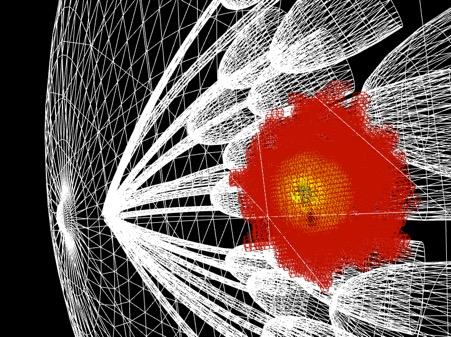
Credit: Tim Harries
Techniques developed by astronomers could help in the fight against breast and skin cancer. Charlie Jeynes at the University of Exeter will present his and Prof Tim Harries team’s work today (3 July) at the RAS National Astronomy Meeting (NAM 2019) at the University of Lancaster.
A large part of astronomy depends on the detection and analysis of light. For example, scientists study the light scattered, absorbed and re-emitted in clouds of gas and dust, obtaining information on their interior.
Despite the vast differences in scale, the processes that light undergoes when travelling through the human body are very similar to those seen in space. And when things go wrong – when tissue becomes cancerous – that change should show up.
In the UK, nearly 60,000 women are diagnosed with breast cancer each year, and 12,000 die. Early diagnosis is key, with 90% of women diagnosed at the earliest stage surviving for at least five years, compared to 15% for women diagnosed with the most advanced stage.
Cancer creates tiny deposits of calcium in breasts, detected through a shift in the wavelength of light as it passes through the tissue. The Exeter team realised that the computer codes developed to study the formation of stars and planets could be applied to find these deposits.
Charlie commented: “Light is fundamental to a diverse range of medical advances, like measuring blood oxygenation in premature babies, or treating port-wine stains with lasers. So there is a natural connection with astronomy, and we’re delighted to use our work to take on cancer.”
Working with biomedical scientist Nick Stone, also at Exeter, the team are refining computer models to better understand how detected light is affected by human tissue. They eventually expect to develop a rapid diagnostic test that avoids unnecessary biopsies, improving the prospects for survival for thousands of women. Work is already underway with clinicians at Exeter’s RD&E hospital to pilot the technology and pave the way for larger clinical trials
In a second project, the Exeter team are using computer models for a potential new treatment for non-melanoma skin cancer (NMSC). This is the most common type of cancer, with more than 80,000 cases reported in England each year. NMSC is expected to cost the NHS £180 million a year by 2020, a figure set to rise as the disease becomes more prevalent.
In a partnership with Alison Curnow of the University of Exeter Medical School, the scientists are using their code to develop a simulated ‘virtual laboratory’ for studying skin cancer treatment. The two-pronged attack looks at light-activated drugs (photodynamic therapy) and light-heated nanoparticles (photothermal therapy).
The simulation looks at how gold nanoparticles in a virtual skin tumour are heated by exposure to near-infrared light. After 1 second of irradiation, the tumour heats up by 3 degrees Celsius. After 10 minutes, the same tumour is heated by 20 degrees – enough to kill its cells. So far, photothermal therapy with nanoparticles has been effective in rats, but with the team’s code to narrow down experimental conditions, they are working towards translating the technology for humans.
Charlie said: “Advances in fundamental science should never be seen in isolation. Astronomy is no exception, and though impossible to predict at the outset, its discoveries and techniques often benefit society. Our work is a great example of that, and I’m really proud that we’re helping our medical colleagues wage war on cancer.”
The next steps include using 3D- rendered models taken from images of real tumours, and simulating how these would respond to different treatment regimes. Data exists on how these tumours responded to treatment, which gives excellent ‘ground truth’ data against which to compare the models. In this way the team will be able to predict whether different types of treatment would be more effective for a particular tumour type, and enable clinicians to have more options when it comes to choosing a treatment plan.
###
Media contacts
Robert Massey
Royal Astronomical Society
Mob: +44 (0)7802 877699
[email protected]
Anita Heward
Royal Astronomical Society
Mob: +44 (0)7756 034243
[email protected]
Kate Arkless Gray
Royal Astronomical Society
[email protected]
Science contacts
Charlie Jeynes
University of Exeter
[email protected]
Interview facilities and access to content
Media representatives are cordially invited to attend the meeting and can register at no cost. Press room facilities will be available in Faraday Seminar Room 2 for the duration of the conference – from 0900 BST on Monday 1 July to 1500 BST on Thursday 4 July. For free registration for the meeting, please contact the press team via [email protected]
Scientists at the conference are also available for interview via both a radio studio and TV studio at Lancaster University; the Globelynx TV network offers broadcast quality HD video to the world’s leading broadcasters and an ISDN line for interviews in a radio booth.
Please book these via the Lancaster University Press Office on +44(0)1524 592612.
Access credentials for embargoed press materials are available on request from the NAM press team via [email protected]
Images and captions
https:/
A computer model showing light following complex paths as it passes through tissue. Credit: Tim Harries
https:/
A model showing light (red/yellow) penetrating the surface of the human breast (white triangles). Credit: Tim Harries
https:/
Simulations of near-infrared light (NIR) penetrating into skin tissue show that after 1 second of irradiation, a tumour (embedded 9 mm into skin tissue) infused with NIR absorbing gold nanoparticles, heats up by about 3 degrees Celsius, while after 10 minutes it has heated up by over 20 degrees Celsius. This is enough of a thermal dose to kill cancer cells. Credit: Charlie Jeynes
https:/
A computer model of skin which has realistic dermal layers and features like sweat glands and hair follicles which can affect the path travelled by light as it travels through the tissue. Credit: Freddy Wordingham
Notes for editors
The full list of authors is Dr Charlie Jeynes, Freddy Wordingham, Laura Moran and Professor Tim Harries, all based at the University of Exeter.
NAM 2019
The RAS National Astronomy Meeting (NAM 2019) is taking place at the University of Lancaster from 30 June to 4 July 2019. It includes the annual meetings of the UK Solar Physics (UKSP) and Magnetosphere Ionosphere Solar-Terrestrial (MIST) groups. The conference is principally sponsored by the Royal Astronomical Society (RAS), the Science and Technology Facilities Council (STFC) and Lancaster University. Full details are visible on the dedicated conference website https:/
About the Royal Astronomical Society
The Royal Astronomical Society (RAS, http://www.
Twitter: https:/
Facebook: https:/
Instagram: https:/
YouTube: https:/
About the Science and Technology Facilities Council
The Science and Technology Facilities Council is part of UK Research and Innovation – the UK body which works in partnership with universities, research organisations, businesses, charities, and government to create the best possible environment for research and innovation to flourish. STFC funds and supports research in particle and nuclear physics, astronomy, gravitational research and astrophysics, and space science and also operates a network of five national laboratories as well as supporting UK research at a number of international research facilities including CERN, FERMILAB and the ESO telescopes in Chile. STFC is keeping the UK at the forefront of international science and has a broad science portfolio and works with the academic and industrial communities to share its expertise in materials science, space and ground-based astronomy technologies, laser science, microelectronics, wafer scale manufacturing, particle and nuclear physics, alternative energy production, radio communications and radar.
STFC’s Astronomy and Space Science programme provides support for a wide range of facilities, research groups and individuals in order to investigate some of the highest priority questions in astrophysics, cosmology and solar system science. STFC’s astronomy and space science programme is delivered through grant funding for research activities, and also through support of technical activities at STFC’s UK Astronomy Technology Centre and RAL Space at the Rutherford Appleton Laboratory. STFC also supports UK astronomy through the international European Southern Observatory.
T: https:/
About Lancaster University
Lancaster is a research-intensive university which combines world-class research with excellent teaching and high levels of student satisfaction.
Lancaster University is among the best in the UK. Top 10 in all three major national league tables, it is also highly ranked in international league tables such as the QS World Rankings.
Its 6th-place ranking in The Times and The Sunday Times Good University Guide 2019, as well as the award of the coveted University of the Year title for 2018, cements its place as an elite UK university.
For more information please see http://www.
Media Contact
Robert Massey
[email protected]




